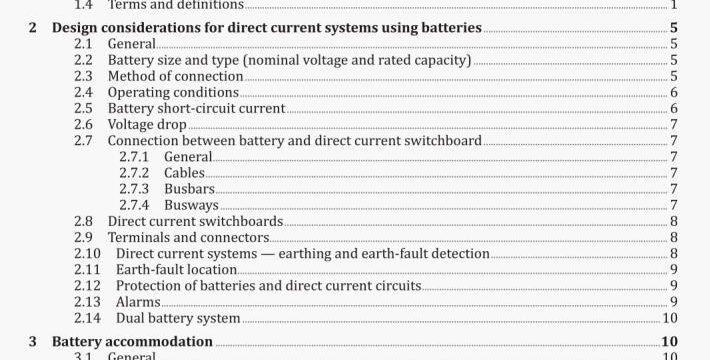Guide to the installation, maintenance, testing and replacement of secondary batteries in buildings
AS 2676.2-2020 pdf download.Guide to the installation, maintenance, testing and replacement of secondary batteries in buildings Part 2: Sealed cells.
2.12 Protection of batteries and direct current circuits
Requirements for protection of output conductors against overcurrent are specified in AS 3011.2.
Protective devices should be selected from the following:
(a) Fuses, refer to AS/NZS IEC 60947.3.
(ii) Combination fuse switch units incorporating HRC fuses, refer to AS/NZS IEC 60947.3.
(c) Miniature circuit-breakers (MCBs), refer to AS/ NZS 3111 or moulded case circuit-breakers (MCCBs), refer to AS 2184.
MCBs and some MCCBs have limited short-circuit current ratings and may need to be backed up by HRC fuses.
The installation should be arranged so that it is possible to isolate the battery.
2.13 Alarms
AS 3011.2 provides requirements for alarms.
Ills desirable to receive early warning of high or low battery voltage for the following reasons:
(a) An indication of low battery voltage warns against —
(i) discharging the battery to an extent that is unsuitable for normal operation of the load; or
(ii) maintaining the battery in a discharged condition.
Either of the above will shorten the life of cells, particularly cells of lead-acid batteries.
(b) An indication of high battery voltage warns against overcharging the battery and reduces the risk of damage to battery-charging equipment.
When a battery Is receiving a charge, other than a float charge, suitable detectors should monitor the battery voltage so that when the battery reaches full charge either the charge rate is reduced automatically, or an alarm is initiated.
When a battery is receiving a float charge, suitable detectors should monitor the battery voltage and initiate an alarm If the voltage exceeds or falls below the normal operating voltage limits of the rectifier or generator which is permanently connected in parallel with the battery.
Detection devices should incorporate a short delay to avoid spurious operation of alarms by transient voltages.
3 Battery accommodation
3.1 General
Installations using secondary batteries vary considerably in size, from large public utility installations to small emergency lighting installations. AS 3011.2 provides requirements for battery accommodation.
3.2 Layout and location
AS 3011.2 contains requirements for the layout of battery rooms and enclosures.
Equipment with exposed arcing contacts shall not be located in areas where hydrogen pockets may form if ventilation were to fail.
The following recommendations apply to battery room layout and location:
(a) The location should be as free from vibration as possible.
(b) Extreme ambient temperatures should be avoided because low temperatures decrease battery capacity and prolonged high temperatures shorten battery life.
3.3 VentilatIon
3.3.1 General
The chemistry of the valve-regulated battery operates on an internal oxygen-recombination cycle which is arranged to suppress hydrogen gas evolution. Hydrogen gas is not recombined in these types of cells to any significant degree.
tinder normal operating conditions, hydrogen gas evolution and venting in valve-regulated cells is much lower than the hydrogen gas released by conventional vented (flooded) cells. The hydrogen suppression efficiency in valve-regulated batteries varies with cell technology, but typically exceeds 80 % for gel cells and 90 % for absorptive glass mat cells.
However, under conditions of overcharge or electrical abuse, significant amounts of hydrogen gas can be generated and emitted from valve-regulated cells. Further, the thermal management of valve-regulated cells under charge is more critical than for vented cells, and generally the valve-regulated cell will be irreversibly damaged when subjected to sustained electrical abuse. Therefore the manufacturer’s recommended charging regime for valve-regulated batteries should be observed.
3.3.2 Rate of ventilation
AS 3011.2 provides requirements for ventilation.AS 2676.2-2020 pdf download.
Guide to the installation, maintenance, testing and replacement of secondary batteries in buildings
